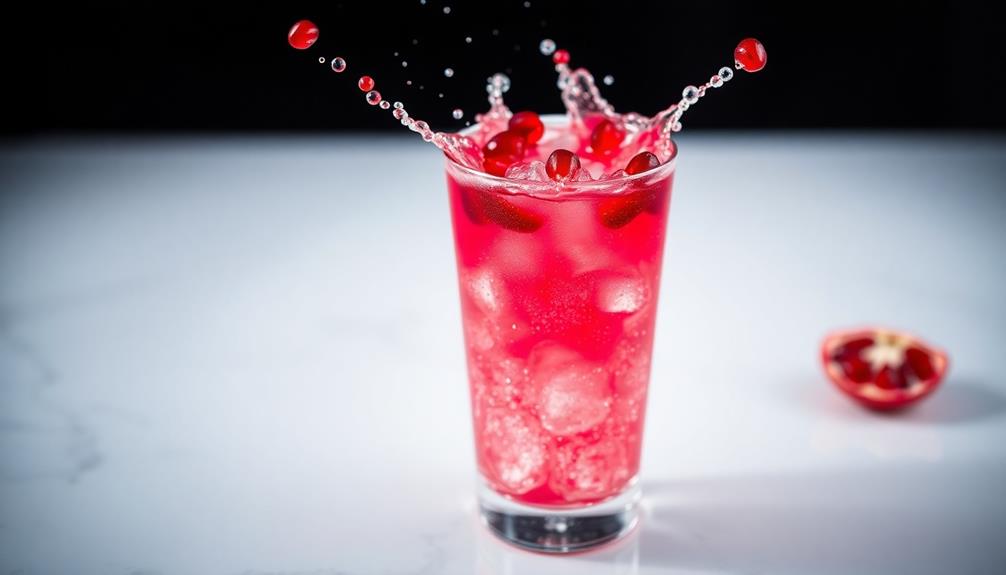There’s something magical about a glass of red wine. It holds the power to transform an ordinary evening into a cherished memory, evoking laughter, deep conversations, and even moments of solace. As you take that first sip, you’re not just tasting a beverage; you’re embarking on a journey through red wine that carries with it the stories of generations, the passion of winemakers, and the essence of the regions where the grapes are cultivated. Here, you’re invited to explore red wine in all its glory—its complexity and richness, the vibrant varieties, and the exquisite sensations that dance across your palate. So, pour yourself a glass and join us as we delve into this enchanting world of flavors and aromas that have delighted senses for centuries.
Key Takeaways
- Red wine offers a rich tapestry of flavors and stories, revealing cultural traditions.
- Varietals like Pinot Noir and Cabernet Sauvignon are known for their distinct characteristics.
- Red wine can enhance social gatherings and intimate moments alike.
- This journey through red wine highlights both historical significance and modern interpretations.
- Understanding red wine opens the door to delightful pairings with food.
- Exploring regional specialties deepens the appreciation for each glass enjoyed.
Introduction to Red Wine
Understanding the essence of red wine offers a gateway into a world rich with flavors and aromas. So, what is red wine? Simply put, red wine is crafted from dark-colored grape varieties. During the fermentation process, the skins, seeds, and stems remain in contact with the juice, imparting color and depth. This red wine overview reveals a spectrum of hues, evolving from deep, opaque purple to lighter ruby shades as the wine ages.

One of the standout characteristics of red wine lies in its tannins, which provide structure and rigidity. Over time, these tannins soften, making young, tannic wines more enjoyable after a few years of aging. Various grape varieties yield distinct flavor profiles. For instance, Cabernet Sauvignon often exhibits notes of currants and black cherries when produced in warmer climates, while Pinot Noir can range from delicate and ethereal in Burgundy to denser styles in California.
In addition to fruit-forward flavors like raspberry and cherry, red wines also showcase earthy undertones, elevating their complexity. Together with organic compounds found in grape skins, these wines offer unique organoleptic properties. You can categorize red wines into three main body types: light-bodied, medium-bodied, and full-bodied, influencing their palate presence and pairing capabilities.
Light-bodied wines, such as Pinot Noir and Gamay, typically have an alcohol percentage below 12.5%. Medium-bodied reds like Merlot and Cabernet Franc strike a balance between tannins and acidity, enhancing their versatility. Full-bodied varieties, including Malbec and Cabernet Sauvignon, come with higher alcohol levels and often present a richer taste experience.
Armed with this introduction to red wine, you can embark on a delightful journey into the nuances and pleasures of red wine tasting, from appreciating rich flavors to exploring versatile pairings that complement your culinary adventures.
The History of Red Wine
The history of red wine spans over seven millennia, showcasing its importance in various cultures throughout time. Evidence suggests that the origins of winemaking can be traced back to around 7000 B.C., primarily emerging from regions such as China, Armenia, and the Caucasus Mountains. Notably, the Chian wine, regarded as one of the earliest types of red wine, dates to approximately 500 B.C.. Different civilizations, including those in Mesopotamia and Ancient Egypt, recognized the importance of wine in both everyday life and ceremonial practices. Wine played a critical role in celebrations, religious rituals, and even trade in ancient societies.
As we explore the historical significance of red wine, one cannot overlook its presence in Roman culture, where it became increasingly popular. Romans not only embraced winemaking but also advanced the techniques by cultivating vineyards across their empire, significantly influencing the wine landscapes of Europe. Interestingly, the world’s oldest known winery, located in the Areni-1 cave in Armenia, dating back to 4100 B.C., highlights the global span of red wine’s history.
Fast forward to modern times, the wine industry has evolved into a $300 billion global market, driven by red wine, which alone accounted for 46% of wine sales as of 2020. The ongoing growth at an estimated rate of over 5% annually showcases the enduring appeal of red wine. Events such as the Phylloxera epidemic in the 19th century reshaped the industry, leading to innovations in viticulture and winemaking practices. Today, major wine-producing countries like Italy, France, and the United States continue to define the landscape of red wine, ensuring generations can enjoy this ancient beverage.
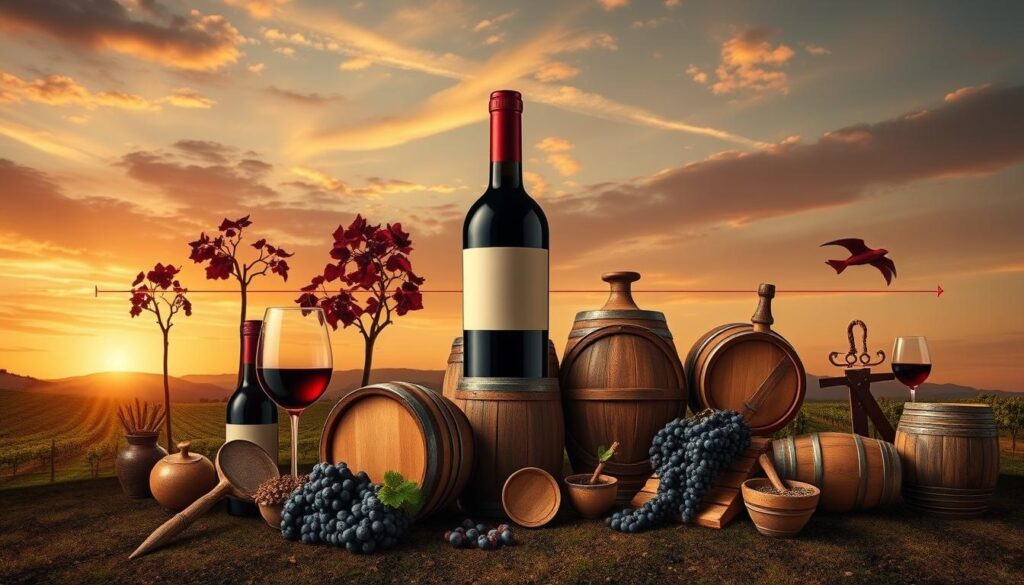
Types of Red Wine
Exploring the types of red wine reveals a diverse range of flavors, aromas, and characteristics. Each variety presents unique traits, catering to different tastes and preferences. Understanding these red wine varieties can enhance your appreciation and help you discover the best red wine types that suit your palate.
Pinot Noir: The Elegant Choice
Pinot Noir ranks among the most popular red wine varieties. Known for its light to medium body, it features delicate flavors such as cherry, strawberry, and earthy notes. This wine pairs excellently with lighter dishes, which makes it a favorite for many wine enthusiasts.
Cabernet Sauvignon: Bold and Robust
As the most planted grape variety worldwide, Cabernet Sauvignon is celebrated for its full-bodied nature. This wine is known for bold flavors of black currant, plum, and oak, making it the perfect companion for hearty meals like steak or lamb. Its strong presence has solidified it among the best red wine types available.
Merlot: Smooth and Accessible
Merlot often surprises those who overlook it. This variety offers a luscious and velvety texture, appealing to both wine beginners and connoisseurs. With notes of plum, chocolate, and spices, it provides a smooth palate that complements various dishes, particularly pastas and roasted meats.
Syrah/Shiraz: Spicy and Rich
Syrah, known as Shiraz in Australia, showcases a remarkable range of flavors. The French Syrah tends to have a leaner profile with black pepper and dark fruit notes, while Shiraz often presents a juicier, fruit-forward taste profile. This versatility makes it an excellent choice for spicy or grilled foods.
Zinfandel: Fruity and Full-Bodied
Recognized as “America’s variety,” Zinfandel bursts with juicy fruit flavors, high spice content, and a fuller body. This type of red wine complements barbecue dishes and rich sauces, making it a crowd-pleaser among wine lovers looking for a flavorful option.
Malbec: Dark and Inky
Malbec has gained immense popularity over the last few years due to its ability to please a broad audience. With its deep, inky color and rich flavors of blackberry, plum, and chocolate, this wine is predominantly produced in Argentina and pairs wonderfully with grilled meats and strong cheeses.
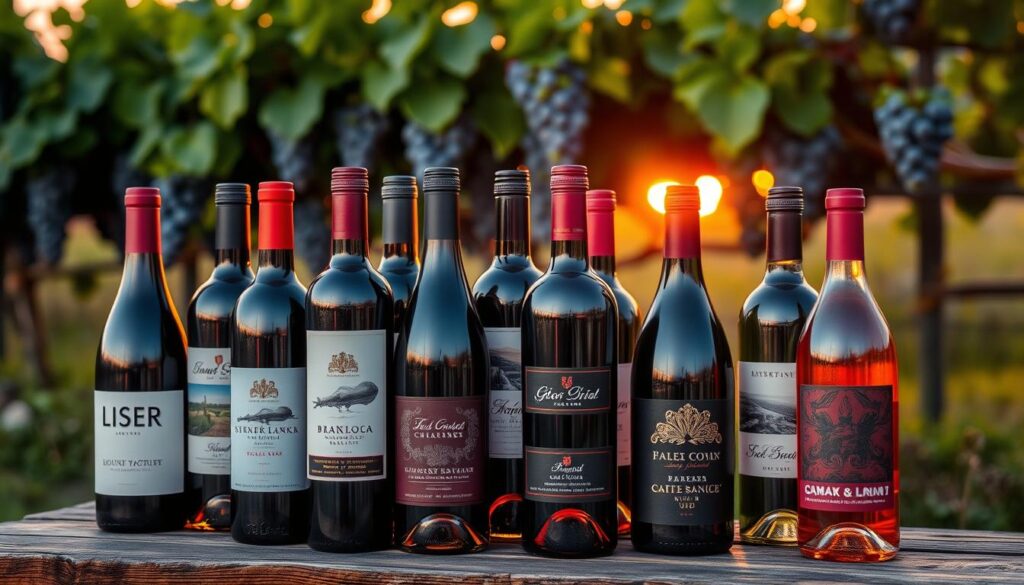
Red Wine Regions of the World
The world of red wine is adorned with both famous wine regions and emerging wine areas. Each region brings its unique blend of climate, soil, and winemaking traditions that contribute to the diversity of flavors and styles in red wine. Understanding these regions enables you to appreciate the nuances and characteristics of each bottle you uncork.
Famous Regions: Bordeaux and Napa Valley
When discussing famous wine regions, Bordeaux, France stands out prominently. Known for its high-quality Bordeaux blends, the region primarily uses Cabernet Sauvignon and Merlot grapes, among others, to create wines that have set benchmarks worldwide. This area boasts over 290,000 vineyards, with a significant majority dedicated to red wines.
Crossing the ocean, you arrive in Napa Valley, California, a cornerstone of red wine production in the United States. This region is celebrated for its bold and fruit-forward Cabernet Sauvignon, which accounts for 40% of its production. The favorable climate allows for a thriving winemaking scene that consistently delivers quality wines.
Emerging Regions: Oregon and Argentina
Shifting focus to emerging wine areas reveals exciting developments in regions like Oregon and Argentina. Oregon has gained recognition for its exceptional Pinot Noir wines, illustrating how innovative winemakers harness the unique terroir to create outstanding vintages. Meanwhile, Argentina shines with its robust Malbec, a varietal that highlights the country’s potential in the global wine market.

| Region | Main Grape Varieties | Characteristics |
|---|---|---|
| Bordeaux, France | Cabernet Sauvignon, Merlot | Blends with depth and complexity |
| Napa Valley, California | Cabernet Sauvignon, Zinfandel | Bold, rich, and fruit-forward wines |
| Oregon | Pinot Noir | Smooth with earthy undertones |
| Argentina | Malbec | Rich and dark with plum notes |
Exploring these red wine regions allows you to appreciate the broader landscape of wine production, where both famous and emerging regions significantly contribute to the global intrigue of red wine. Whether you choose to visit the classic red wine regions of Bordeaux and Tuscany or explore the up-and-coming areas of Chile’s Maipo Valley or South Africa’s Stellenbosch, there is always something new and exciting to discover in the world of red wine. If you’re a wine enthusiast, why not plan a wine country trip to immerse yourself in the culture and flavors of these diverse regions? It’s the perfect way to deepen your appreciation for the art of winemaking and taste some of the best red wines in the world.
Red Wine and Health Benefits
Delving into the health benefits of red wine reveals intriguing findings that may surprise you. Resveratrol, a powerful antioxidant found in red wine, is commonly linked to cardiovascular health. This polyphenol might help prevent coronary artery disease, a common precursor to heart attacks. Studies indicate that the antioxidants present could aid in raising high-density lipoprotein (HDL) cholesterol levels, commonly referred to as “good” cholesterol. Elevated HDL can protect against the buildup of harmful cholesterol that threatens heart health.
Moderate consumption of red wine plays a role in promoting overall cardiovascular benefits. It might help decrease blood clot risks and combat inflammation, making it a favorable choice for some individuals looking to safeguard their heart. While many enjoy exploring the benefits of red wine as part of a balanced lifestyle, moderation remains essential. Health experts define moderate intake as one drink per day for women and up to two for men.
While the alluring notion of drinking red wine for health has merit, it’s crucial to recognize potential risks. Excessive consumption can lead to severe health issues, including liver damage and various cancers. The American Heart Association advises that if you don’t currently drink alcohol, you shouldn’t start solely for these red wine health benefits. Overall well-being should guide alcohol choices, and finding a balance is vital.
Furthermore, research suggests that the consumption of red wine not only favors heart health but may contribute positively to gut health, supporting beneficial gut microbiota. Some studies even hint at a link between moderate red wine consumption and reduced dementia risks. The varied advantages of resveratrol found in red wine extend across multiple health dimensions, supporting brain function, reducing inflammation, and possibly enhancing longevity-related gene expression.
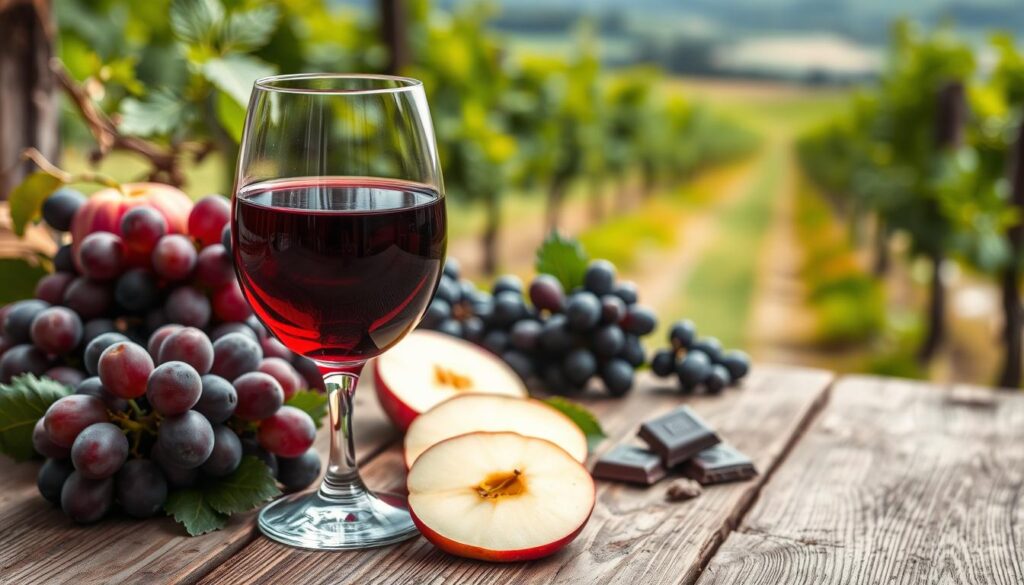
In conclusion, recognizing the nuanced effects of red wine is essential. Incorporating it into a healthy lifestyle may offer considerable benefits when done responsibly. As with all things related to nutrition and wellness, moderation along with informed decisions remains the cornerstone of enjoying red wine for health.
Best Red Wine Brands to Try
Exploring the world of red wine unveils a wealth of amazing brands, each offering unique flavors and experiences. When searching for the best red wine brands, consider both local gems and renowned international labels. This journey will enhance your wine knowledge and palette.
Top Producers in California
California is famous for producing some of the best red wine brands in the world. Exceptional wines from this region showcase bold flavors and unparalleled quality. Notable producers include:
- Robert Mondavi – A hallmark of California wines renowned for its rich varieties.
- Silver Oak – Celebrated for its exquisite Cabernet Sauvignon.
- Jordan Vineyard & Winery – Offers a balanced approach to winemaking with a focus on elegant flavors.
If you seek top California wines, these brands often stand out in tastings and garner high ratings from critics.
Noteworthy International Brands
International red wine producers provide even more opportunities to discover remarkable selections. Talented winemakers from around the world create wines that are highly sought after:
- Château Margaux – This iconic French estate is revered for its exquisite Bordeaux blends.
- Gérard Bertrand – A leader in the production of high-quality Languedoc wines, offering a variety of rich flavors.
This selection encourages you to explore diverse red wine options across various price ranges and regions. With each bottle you try, you expand your knowledge and appreciation for the best red wine brands.

Red Wine Pairing: Perfect Matches for Your Meals
The art of red wine pairing with food elevates your dining experience by enhancing individual flavors and creating a delightful harmony between your meal and the wine. Understanding how to select the best food pairings for red wine can turn a simple dinner into a memorable occasion. Explore classic and contemporary pairings to impress your guests and enjoy your meals even more.
Classic Pairings with Cheese and Meat
Classic red wine pairings often feature robust combinations that complement rich flavors. Here are some beloved choices:
- Pinot Noir with creamy Brie cheese creates a delightful contrast.
- Cabernet Sauvignon pairs perfectly with grilled steaks, enhancing the taste of both the meat and the wine.
- Merlot and beef bourguignon create a smooth synergy, bringing forth fruity and velvety notes.
- Shiraz complements lamb chops, showcasing its boldness and spiciness.
Creative Pairings for Contemporary Dishes
Breaking traditional boundaries can lead to unique and exciting flavor combinations when pairing red wine with food. Consider these innovative suggestions:
- Zinfandel fits well with spicy Asian dishes, making for a surprising and enjoyable pairing.
- Syrah goes wonderfully with BBQ ribs, enhancing the savory and smoky flavors.
- Pinotage pairs with roast duck, bringing out deep, dark berry flavors and a touch of smokiness.
- Nebbiolo invites you to explore wild mushroom risotto for an earthy and elegant experience.
The key to successful red wine pairing lies in understanding flavor profiles. Consider the body of your wine as it should match the weight of your food. Light-bodied wines work well with salads, while fuller-bodied options like Syrah complement heavier dishes like beef stew perfectly. By embracing these pairing guidelines, you can create culinary experiences that are both sophisticated and enjoyable.
| Wine | Best Food Pairing |
|---|---|
| Pinot Noir | Brie cheese |
| Cabernet Sauvignon | Grilled steak |
| Merlot | Beef bourguignon |
| Shiraz | Lamb chops |
| Zinfandel | Spicy Asian dishes |
| Syrah | BBQ ribs |
| Pinotage | Roast duck |
| Nebbiolo | Wild mushroom risotto |
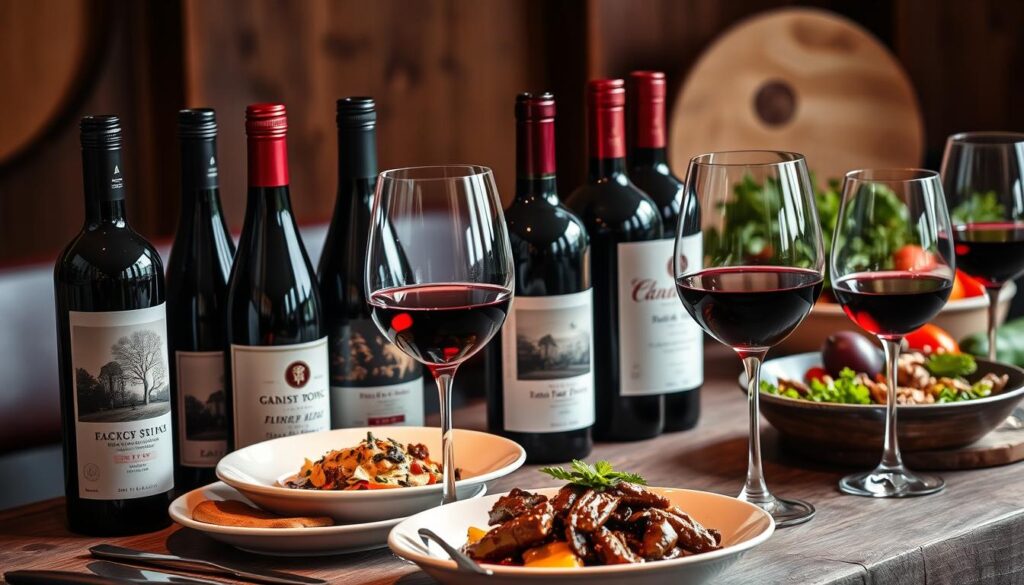
Red Wine Varieties and Their Flavors
Flavors in red wine can vary immensely based on grape variety, region, and the winemaking process. Understanding red wine types is crucial for discerning wine enthusiasts. Each variety presents a unique set of flavors that can captivate your palate.
For example, Cabernet Sauvignon ranks as one of the most popular red wine varieties globally. Its characteristic notes include black cherry, bell pepper, and herbs. This variety serves as the backbone for renowned wines from Bordeaux and Napa Valley.
Merlot offers a versatile flavor profile, ranging from fruit-forward and sweet to more structured and nuanced options that enhance its aging potential. This variety is often a fundamental component in Bordeaux blends, showcasing spice and cherry notes that enchant wine lovers.
Pinot Noir, renowned for its delicacy, brings flavors of pie cherry, anise, and even tobacco leaf. This unique grape can also be used to produce delightful rosé wines, highlighting its versatility. Syrah, frequently crafted as a red wine, showcases bold raspberry and blackberry notes, making it a favorite in many regions.
Zinfandel truly shines in the United States, recognized for its peak quality and expressiveness. Often labeled with the grape’s name on the bottle, Zinfandel displays flavors of ripe fruit and spiciness. On the other hand, Malbec primarily presents sour cherry and spice notes, with most production occurring in Argentina.
Let’s take a closer look at the flavors associated with various red wine varieties in the table below:
| Grape Variety | Typical Flavors |
|---|---|
| Cabernet Sauvignon | Bell pepper, black cherry, herbs |
| Merlot | Spice, cherry |
| Pinot Noir | Pie cherry, anise, tobacco leaf |
| Syrah | Raspberry, blackberry |
| Zinfandel | Ripe fruit, spice |
| Malbec | Sour cherry, spice |
| Sangiovese | Blackberry, boysenberry, plum |
| Nebbiolo | Tomato leaf, pale cherry, blackberry |
| Grenache | Spice, cherry |
| Cabernet Franc | Violets, blueberry, earthy |
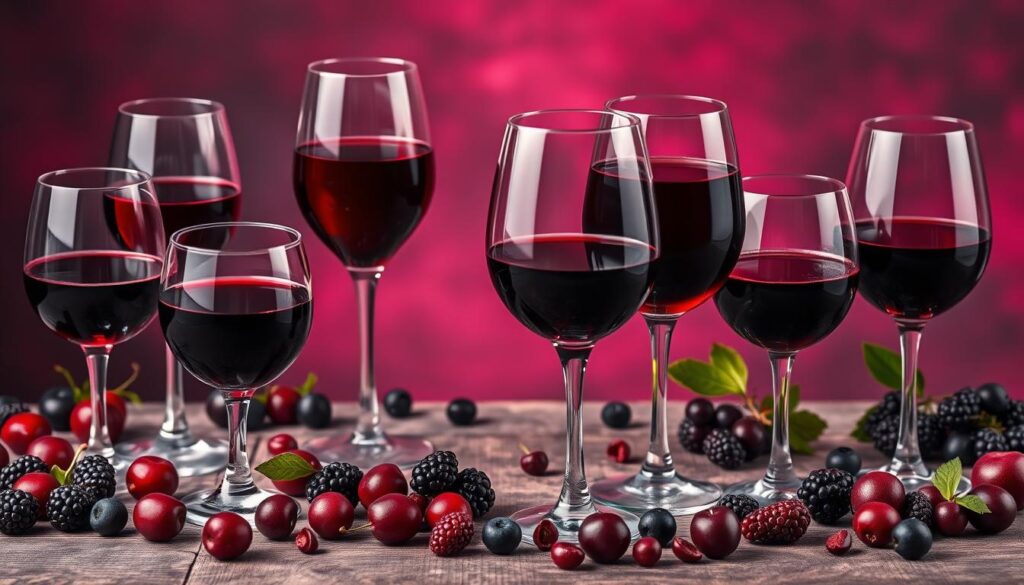
With this knowledge of red wine flavors, you can better appreciate the nuances in each sip, allowing your experiences to deepen with each tasting. Understanding these flavors significantly enhances your overall wine enjoyment and food pairings.
Understanding Red Wine Reviews
When diving into the intricate world of red wine, understanding red wine reviews is essential for choosing your next favorite bottle. Navigating wine ratings and descriptions may initially seem overwhelming. Familiarizing yourself with common wine rating systems, like the 100-point scale, simplifies this process. Descriptors you frequently encounter, such as “jammy” or “tannic,” reveal a lot about a wine’s profile and how it might complement your palate.
Deciphering Wine Ratings and Descriptions
Wine ratings often reflect the quality and characteristics of any given bottle. For example, a highly rated Merlot may reveal its rich cherry and chocolate flavors, which are popular for their versatility and easy pairing with various dishes. Understanding these ratings helps you identify which wines suit your taste preferences. Wines like Montes Alpha Carménère, known for its smooth and rich texture, exemplify good value, particularly for those exploring different styles. Similarly, the GSM blend, made from Grenache, Syrah, and Mourvèdre, provides a delightful exploration of flavors, often rated highly on various platforms.
Where to Find Trusted Reviews
Finding reliable wine review sources enhances your buying decisions. Reputable wine magazines and websites offer insights and detailed reviews that guide your selections effectively. Some trustworthy sources include:
- Wine Spectator
- Wine Enthusiast
- Decanter
- The Wine Advocate
By consulting these credible platforms, you can make informed choices. Embrace the journey of red wine reviews to discover new favorites tailored to your taste while enjoying a richer wine selection experience.
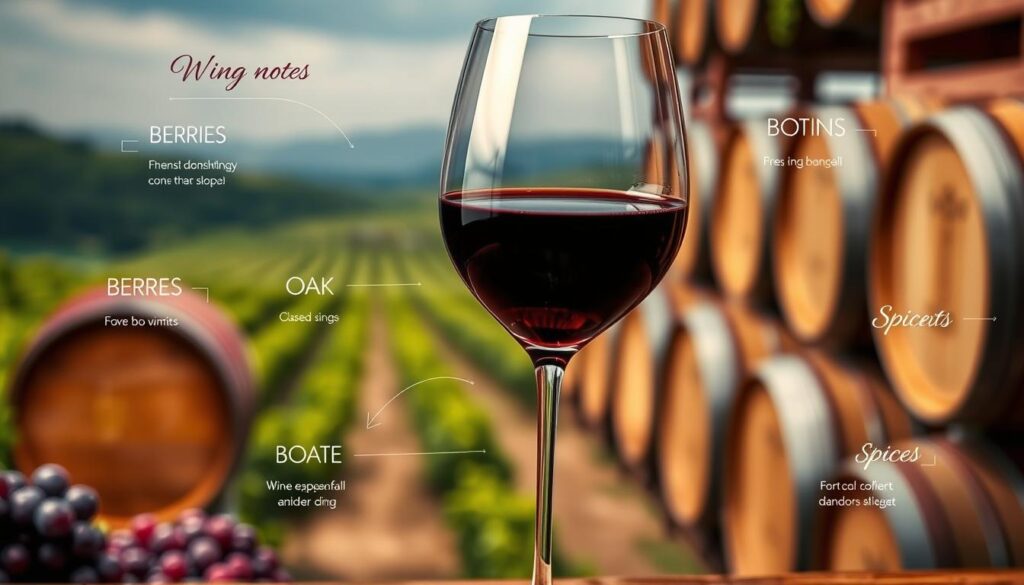
Conclusion
The world of red wine is indeed a diverse tapestry woven with rich history, various types, and a multitude of regions renowned for their unique offerings. This red wine summary illustrates how each varietal, from the elegant Pinot Noir to the bold Cabernet Sauvignon, brings something special to your glass. Throughout this exploration, you’ve discovered not only the flavor profiles that define red wine but also the health benefits it can offer when enjoyed responsibly.
As you indulge in your next glass, keep in mind the journey that each bottle represents—from grape harvesting to fermentation, aging, and finally, bottling. These processes highlight the artistry and science that contribute to the final product. The conclusion on red wine emphasizes the joy of tasting, pairing, and sharing experiences that enhance your appreciation for this exquisite beverage.
In your ongoing adventure with red wine, allow your palate to be your guide. Whether you’re sipping a well-aged bottle or a youthful vintage, the possibilities for delightful exploration are endless. As you enjoy these final thoughts on red wine, remember to celebrate the moments shared with friends and loved ones, raising a glass to the delightful sips that lie ahead!





